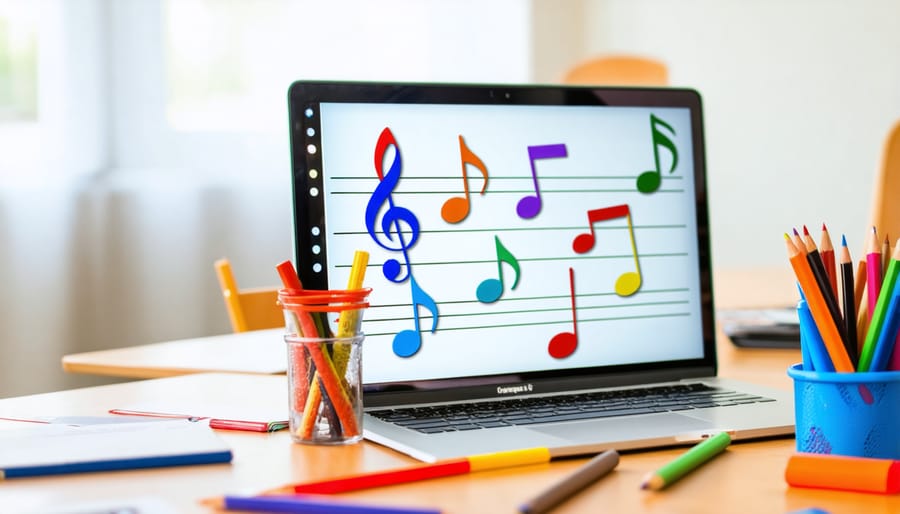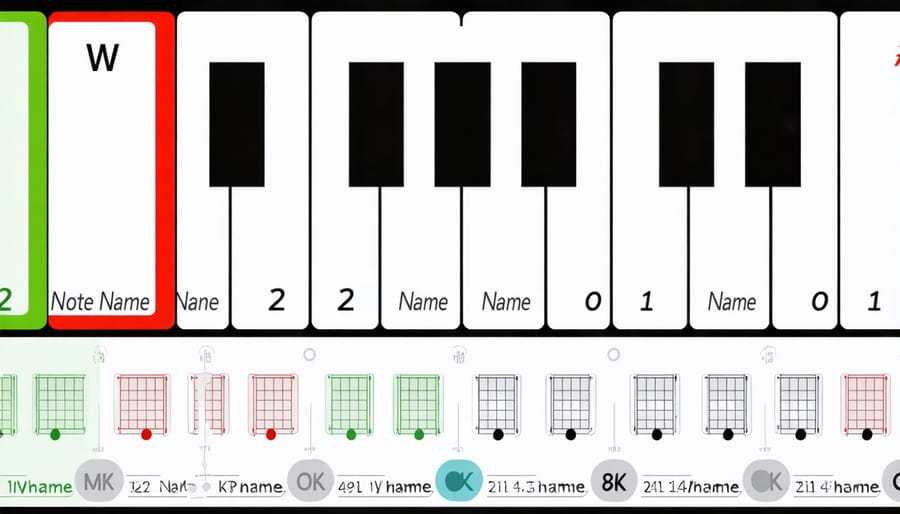Note Name Games That Make Music Class Actually Fun
Transform note reading from drill-and-kill worksheets into games your students actually beg to play. Use flashcard relay races where teams sprint to the board, identify notes on staff cards, and write letter names before passing the marker to teammates. Project PowerPoint slides with timer challenges that display treble and bass clef notes for 5-second quick responses, ramping up speed as students gain confidence. Create “musical bingo” cards with note names instead of numbers, calling out staff positions while students mark their boards with dried beans or counters.
Mix individual and team formats to maintain engagement across your entire class period. Set up stations where small groups rotate through different activities: one table plays matching games pairing staff notation with letter names, another uses magnetic notes on portable whiteboards for hands-on manipulation, while a third competes in digital challenges. Award simple point systems or class privileges to winning teams, keeping competition friendly and motivating.
Differentiate instantly by adjusting note ranges. Beginners focus exclusively on treble clef lines and spaces using mnemonic helpers, while advanced students tackle ledger lines, both clefs simultaneously, or identify notes under time pressure. These games require minimal prep, work for grades K-8, and deliver the repetition students need without the monotony they resist.
Why Note Name Games Work Better Than Flashcards
Let’s be honest—flashcards have their place, but when it comes to learning note names, games are where the magic happens. Here’s why game-based learning wins every time.
First, games naturally boost engagement. Instead of passively flipping through cards, students become active participants. They’re motivated by points, teamwork, and friendly competition. That energy translates into focus, and suddenly your most reluctant learner is shouting out “That’s a B on the treble clef staff!”
Retention improves dramatically too. When students associate note names with positive emotions and movement, their brains create stronger memory connections. Playing a game where they race to identify notes or collaborate with classmates creates multiple pathways for remembering information. It’s not just rote memorization anymore—it’s an experience.
Perhaps most importantly, games reduce the anxiety that often comes with music literacy. Flashcards can feel like testing, which triggers stress for many students. Games create a low-pressure environment where mistakes become learning opportunities rather than failures. Students feel safe to guess, try again, and celebrate progress.
The best part? You can easily customize games to match your students’ skill levels and learning styles. Whether you need a quick five-minute warm-up or an in-depth review session, note name games adapt to your classroom needs while keeping everyone engaged and excited about learning music.

Quick Note Name Games That Need Zero Prep
Around the World Note Race
Get your students moving with this energizing relay-style game! Place note flashcards or posters at stations around your classroom—on walls, desks, or even the floor. Students race from station to station, identifying each note name correctly before moving to the next checkpoint.
You can customize this game brilliantly for different skill levels. Beginners might identify treble clef notes only, while advanced students tackle both clefs or even ledger lines. Try adding a twist by requiring students to sing or play each note before continuing, or have them collect tokens at each station to turn in at the finish line.
The competitive element keeps energy high, but you can easily adapt it for collaboration too. Have students work in pairs where one identifies the note while their partner confirms it’s correct. This game needs minimal prep—just print flashcards or write notes on paper—making it perfect for those days when you need something engaging fast.
Musical Chairs with Note Names
Get everyone moving with this active twist on a beloved classic! Set up chairs in a circle (one fewer than the number of students), and place a different note name card on each chair. As music plays, students walk around the circle. When the music stops, they must quickly sit down and correctly identify the note on their chair before they’re safe. The student left standing is out, but here’s the educational twist: they must also identify a note name before leaving the game to keep learning even when eliminated.
To customize for different skill levels, try these variations: use only treble clef notes for beginners, mix treble and bass clef for intermediate students, or add ledger line notes for advanced learners. You can even require students to name the note and sing its pitch for an extra challenge. This game works beautifully for any grade level and needs minimal prep—just print note cards and press play on your favorite classroom music!
Hot Potato Note Challenge
Turn up the energy with this quick-paced game that gets everyone involved! Grab a soft ball, beanbag, or even a stuffed animal to serve as your hot potato. Students stand or sit in a circle and pass the object around while music plays. When you pause the music, whoever is holding the object must call out a note name from a flashcard you’re holding or from a note displayed on your board.
Want to add excitement? Use a timer set for random intervals instead of music. Students who successfully identify their note stay in the game, while those who need extra practice can become your helpers, showing flashcards to other players. This game works beautifully for all grade levels because you control the difficulty by choosing which notes to include. Beginners can start with just three notes, while advanced students can tackle ledger lines and accidentals. The best part? Zero prep time needed, and you’ll have students begging to play again tomorrow!
Simon Says: Staff Edition
Transform the classic game everyone knows into a musical note-naming powerhouse! In this version, you’re “Staff” instead of “Simon,” and students only follow commands that start with “Staff says.” Call out instructions like “Staff says point to middle C” or “Staff says show me the treble clef G.” Then throw in a trick command without the magic words: “Touch your head if you see a quarter note.” Students who follow commands without “Staff says” sit down for that round.
This game works beautifully as a quick five-minute energizer or brain break between lessons. Keep it fresh by switching up the note identification methods—use flashcards, point to notes on a wall chart, or have students draw notes in the air. The movement component helps kinesthetic learners while the listening element keeps everyone focused and engaged. Plus, you can easily differentiate by adjusting the complexity of notes you call out based on your students’ skill levels.
PowerPoint Note Name Games for Maximum Engagement

Game Show Format Games
Game shows bring instant excitement to note name practice! Transform your music classroom into a buzzing game show studio using PowerPoint game templates designed for educational settings. These formats work beautifully for note identification because students already know the rules and love the competitive atmosphere.
Set up a Jeopardy-style board with categories like “Treble Clef Notes,” “Bass Clef Notes,” “Ledger Lines,” and “Sharps and Flats.” Students or teams choose their point values and race to identify the displayed note. The higher the points, the trickier the note position. You can easily customize difficulty levels for different grades.
Family Feud formats also work great—survey your class beforehand about common note-reading mistakes, then turn those responses into game questions. Quiz bowl formats keep everyone engaged as teams buzz in to identify notes shown on flashcards or your digital board.
The best part? These templates are reusable throughout the year. Simply swap out the note names for different concepts, and you have fresh content ready in minutes. Students stay motivated because the game show atmosphere makes practice feel like entertainment rather than drill work.
Customizing Templates for Different Skill Levels
The beauty of PowerPoint note name games is how easily you can tweak them to match your students’ abilities. Whether you’re working with kindergarteners just learning treble clef or advanced students tackling ledger lines, a few simple adjustments make all the difference.
For beginners, start with fewer notes and more visual support. Limit your slides to just three or four notes (like C, E, and G on the treble staff) and use color-coding to highlight each line and space. Add fun graphics or silly characters that live on specific notes to create memorable associations. Give students extra time per question, maybe 10-15 seconds instead of 5, and celebrate every correct answer enthusiastically.
Intermediate students can handle the full staff range and faster pacing. Mix in both treble and bass clef questions, reduce the timer to 7-8 seconds, and introduce team competitions to raise the energy. Try adding bonus rounds where identifying notes quickly earns extra points.
Advanced learners thrive on challenge, so include ledger line notes, grand staff reading, and even key signature connections. Speed up the timer to 5 seconds or less, add distracting elements like multiple-choice options with similar-looking notes, or require students to name the note AND its position in a specific scale.
The secret is keeping everyone engaged without frustrating anyone. Watch your students’ responses and adjust on the fly. If they’re breezing through, make it harder. If they’re struggling, simplify immediately. Your flexibility makes these games work beautifully for every skill level in your classroom.
Team-Based Note Name Competitions
Relay Race Note Challenges
Get your students moving with relay race note challenges that turn music theory into an exciting physical activity! This team format keeps everyone engaged and brings a burst of energy to your classroom.
Here’s how it works: Divide your class into teams of 4-5 students. Place flashcards with musical notes at one end of your classroom or hallway. Students take turns racing to grab a card, identify the note name out loud, and run back to tag the next teammate. The first team to correctly identify all their notes wins!
You can customize this game in so many ways. Try having students spell words using note names (like FACE or BAD), or increase difficulty by including ledger lines for older students. For younger learners, use only treble clef notes on the staff lines.
Want to add more challenge? Include a whiteboard station where students must write the note name before racing back. This combines physical movement with writing practice, perfect for kinesthetic learners who need to move while learning.
The competitive element motivates even reluctant students, and the team format encourages peer support. Plus, you’ll love how this activity naturally differentiates as faster students help teammates who need extra support.

Note Name Bingo Teams
Turn traditional note name bingo into an exciting team challenge! Divide your class into small groups of 3-4 students and give each team one bingo card to share. This collaborative approach encourages students to work together, discuss their answers, and learn from each other while practicing note recognition.
Here’s how it works: Display notes on the board or screen, and teams must agree on the note name before marking their card. This built-in discussion time helps struggling students learn from their peers without feeling singled out. Award points for bingo patterns, and consider bonus points for teams that can explain their reasoning.
Want to add more excitement? Try these twists: use relay-style gameplay where one team member runs to mark the card, create tournament brackets with winning teams advancing, or assign different point values to various notes. You can explore more classroom bingo variations to keep things fresh throughout the year.
This format works beautifully for mixed-ability classrooms because stronger students naturally support those still developing their skills. Plus, the team energy keeps everyone engaged and motivated to participate!
Adapting Note Name Games for Different Grade Levels
Elementary Modifications
When working with your youngest music students, start by simplifying games to focus on just two or three note names at a time. Instead of the full staff, use flashcards with just the treble clef lines or spaces. Consider beginning with C, E, and G before adding more complexity.
Shorten game rounds to 3-5 minutes to match shorter attention spans. Use bigger visuals and allow students to respond with physical movements like jumping, clapping, or pointing rather than writing answers. Partner activities work wonderfully at this level, letting confident learners support those still mastering basics.
Color-coding is your secret weapon! Try assigning colors to different notes temporarily as a learning scaffold. For example, all C notes might wear red stickers on classroom instruments or appear in red on your game materials.
Keep instructions super simple with just one or two rules. The goal is building confidence and familiarity with note names through repetition and success. Remember, celebrating small wins keeps elementary students motivated and eager to play again tomorrow.
Middle and High School Challenges
Older students thrive on challenge, so it’s time to level up those note name games! Introduce ledger lines above and below the staff to expand their reading range. Students in middle and high school can handle multiple ledger lines, preparing them for actual repertoire they’ll encounter.
Add key signatures to keep things interesting. Instead of sticking with C major, challenge students to identify notes in keys with sharps and flats. This builds the dual skill of reading note positions and applying key signatures simultaneously.
Speed becomes your secret weapon for engagement. Use timed rounds where students race against the clock or compete in teams. Digital presentations work wonderfully here because you can control the pace and gradually increase difficulty.
Consider mixing clefs too! Instrumentalists often need to read both treble and bass, so alternate between them or show them together. Create customized games that match your curriculum, whether you’re prepping for All-State auditions or introducing jazz chord symbols. The key is making complexity feel like an exciting challenge rather than overwhelming work.
Making Note Name Games Part of Your Routine
The secret to success with note name games isn’t finding more time—it’s making them work within the time you already have. Start small by using a quick five-minute game as your lesson opener. This activates prior knowledge and gets students mentally ready for more complex musical concepts.
Brain breaks are perfect opportunities too. When you notice energy dipping mid-lesson, pause for a two-minute rapid-fire note identification challenge. Students refocus while reinforcing essential skills without feeling like they’re doing extra work.
Consider designating one day weekly as “game day” for review. Friday afternoons work wonderfully for team competitions that recap the week’s learning. You can rotate through different game formats to keep things fresh and maintain enthusiasm.
For maximum efficiency, prep materials in batches. Create a dedicated folder with printed games, flashcards, or digital files ready to grab at a moment’s notice. Keep a rotation schedule so you’re not scrambling to plan activities.
The key is consistency without rigidity. When games become expected parts of your routine rather than special treats, students stay engaged and retention improves dramatically. You’ll be amazed how much learning happens when it doesn’t feel like traditional instruction.
You don’t need to transform your entire music curriculum overnight. Start with just one game that excites you and fits your next lesson. Maybe it’s a quick round of Note Name Bingo on Friday or a five-minute relay race before spring break. Watch how your students respond, then gradually add more activities to your rotation.
The beautiful truth about making note learning fun is simple: students who enjoy practicing are students who keep practicing. When kids associate music reading with laughter and friendly competition rather than frustration, you’re not just teaching notes. You’re building confident, enthusiastic musicians who’ll carry these skills far beyond your classroom.
Ready to dive in? You’ll find customizable game templates and printables designed specifically for busy teachers who want maximum engagement with minimal prep time. Pick one game, give it a try, and watch your students light up!


